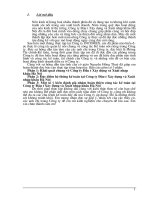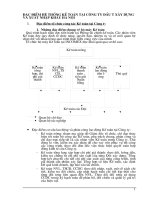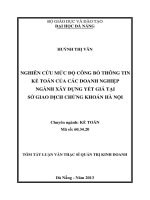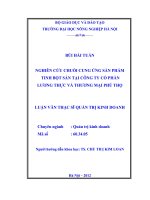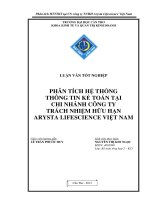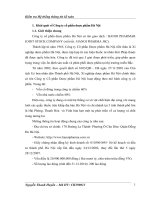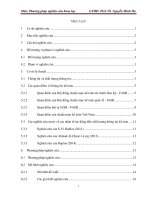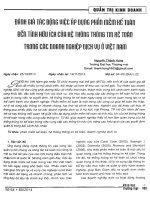Nghiên cứu xây dựng hệ thống thông tin kế toán tại các doanh nghiệp xây dựng việt nam triển khai thử nghiệm tại công ty đầu tư xây dựng và thương mại đất việt tt tiếng anh
Bạn đang xem bản rút gọn của tài liệu. Xem và tải ngay bản đầy đủ của tài liệu tại đây (187.83 KB, 12 trang )
1
2
INTRODUCTION
1. The necessity of the thesis
Amid the current international economic integration context, Vietnam
enterprises suffer big competitive pressure not only from domestic counterparts
but also from giant multinational corporations strong in capital, brands and
management capacity. Accounting is known as a sharp and effective weapon for
enterprises in making plans and managing business operations. To develop
sustainably, enterprises need to have various factors, of which the very crucial is
a good accounting system. As globalization is increasing, the application of
information technology in accounting work has become common.
Computerizing accounting not only processes and provides information
accurately, rapidly and conveniently but also increases labor productivity and
raises accounting efficiency. Reality has shown that in recent years, the
Communist Party and Government have paid special attention to the
development and application of information technology to boost the national
cause of industrialization and modernization and affirmed that “Computerizing
management plays an important part and is a regular task of organizations to
raise management capacity, productivity, quality and efficiency. Enterprises
need to invest in information applications, considering them a fundamental
measure to renovate management” (Politburo, 2000). This guideline has been
reflected by different circulars and policies which specify the tasks of relevant
agencies in setting, implementing, supervising and evaluating action plans so as
to turn information technology applications into a new form of development,
raise operational performance and competitiveness to catch up with other
countries in the world. In this guideline, information systems play an essential
role in grasping new development opportunities, accelerating regional and
international integration process and renovating production. This may result in
dramatic changes in business areas as well as management of enterprises.
Information systems help to improve labor productivity, provide information
accurately, shorten work time, save human resources and raise performance. The
application of the information systems becomes an inevitable trend with great
practical significance in raising business management quality.
Besides, the necessity of developing the information system also roots
from the demand for integration with the world economy. Vietnam has officially
joined in various international economic forums such as AFTA (1995), APEC
(1998) and WTO (becoming its 150th member in late 2006); entered ASEM in
2010, signed Vietnam-EU Free Trade Agreement (FTA) in 2015, VietnamEAEU FTA in 2015, Trans-Pacific Partnership Agreement in 2016. Since 2017
the entire world has entered the fourth Industrial Revolution - an era with new
technological applications in building information system with The Internet of
things, Artificial Intelligence, Virtual Reality, Augmented Reality, Social
Network, Cloud and Mobile Computing, Big Data which have transformed the
real world into digital world in all aspects of socio-economic life. Information
systems play an increasingly important role in the development of the society,
an essential element to connect and exchange with the whole world to create,
store, transmit, process and exploit information. This revolution is a new trend
with considerable impacts on the society and economy of every nation, region
and the entire world, including Vietnam. More and more foreign corporates have
come to Vietnam. If Vietnamese enterprises do not apply information systems to
facilitate their management, they will lose their market share to foreign rivals
and gradually become outdated.
Construction represents one of the key sectors in Vietnam’s national
economy. Along with the development of the country, the scale and market of
the construction sector are rapidly expanding, its production process is being
socialized. In the world, depending on the country’s growth level, the
contributions of the construction sector to the economy vary greatly, ranging
from 3% to 10% of GDP. In Vietnam, this ratio is 6% - 7% (according to
Vietnam Chamber of Industry and Trade, 2016).
According to the report of Ministry of Construction in 2017, the
construction industry maintained a quite high growth rate of 8.7% over 2016,
contributing 0.54 percentage point to national growth rate, ranking third among
sectors with high percentage point contribution to the country’s GDP. Under the
forecast of BIM, the construction industry will grow at 6.6 % annually in the
2017 – 2025 period. Construction enterprises belong to infrastructure creating
sector in the economy. The construction sector is expanding and developing
under different forms including state owned, joint stock, private, limited and
informal. To integrate into the world economy, construction enterprises need to
strengthen their financial management solutions so that they can save costs in
each construction work.
The construction industry has some typical features such as products are
construction and architecture projects of big scales, complex structures, longterm completion period, these features can affect the process of informatic
application in the accounting system. Besides the normal accounting practices,
construction accounting needs to perform some functions such as making
estimates (estimating designs and construction), managing fixed assets,
adjusting annual asset depreciation and accumulated depreciation. Besides,
3
4
product prices are calculated on the basis of negotiations with investors or
estimates. Assets are fixed at construction sites while facilities, materials, labor
force are mobile on each project. This makes it difficult to control the quality
and quantity of materials exported from warehouses; managing assets, labor
force and materials in the construction sites as well as creating accounting for
production costs depend on various factors. Besides, upon completion, products
are used for a long time and difficult to change, so if products are not approved
after checks, they need rebuilding, thereby increasing costs. For these reasons,
managing and supervising the construction and calculating process need to be
implemented thoroughly to ensure that the quality of the construction work
meets the estimated designs. Particularly, accounting work in construction
enterprises often focuses on the process of accounting construction costs
implemented via the combination of three forms of calculation: profession
calculation, statistical calculation and accounting calculation. Therefore, the
optimal solution that many enterprises are using at present is to research and
apply the accounting information systems to increase the efficiency of
accounting work in construction enterprises.
According to statistics of Construction Research Institute, there were over
1000 enterprises under Ministry of Construction in 2017. Most enterprises have
been equipped with information technology infrastructure with LAN and
Internet connection. However, the application of information system remains
quite limited. Some enterprises face difficulties in processing, analyzing and
synthesizing accounting figures to make financial statements and statistical
reports to facilitate the decision-making of the management boards. Moreover,
as the demand for controlling and using information of users varies, accounting
information is generally classified into two kinds: financial reports and
management reports. The survey findings indicate that most enterprises use
financial reports to provide information for the making of financial reports for
managers and external subjects such as tax agencies, banks and investors; they
usually lack information for management reports that serve internal management
and control.
All the same, in the face of pressure from international economic
integration amidst the faster and stronger development of technology,
construction enterprises also have the needs to change to an appropriate
accounting software or upgrade their systems with additional functions so that
they can manage the financial-accounting work more comprehensively. The
complete replacement of the old software with a totally new one costs time and
money. Besides, when upgrading the system, problems may arise when the old
and new softwares have drastic differences in terms of technology, data
accessing and processing modes. To deal with these problems, the Enterprise
Application Integration (EAI) has been proposed to integrate new applications
into the existing ones to create a united system capable of sharing data among
applications, using prevailing infrastructure, recycling old software, thereby
increasing economic efficiency. EAI helps enterprises to save costs of setting up
the totally new system, enables them to apply different new solutions by
integrating the applications of various manufacturing firms.
In that sense, it is of great importance to conduct thorough and systematic
research on the computerization of the accounting information systems in
Vietnam’s construction enterprises so as to work out solutions and proposals to
complete the systems amid the context of development and integration.
Therefore, the dissertation titled “Research to Build Accounting Information
System in Vietnam’s Construction Enterprises – Pilot Implementation in Dat
Viet Investment Construction Trading Company” has both theoretical and
practical significance to boost the development of accounting information
system in the context of the fourth Industrial Revolution.
2. Research objectives and research questions
Overall objectives: On the basis of evaluating the current level of
computerization in construction enterprises and the needs to improve this issue,
the dissertation aims to design a synchronously-computerized accounting
information system for Vietnam’s construction enterprises.
Specific research tasks:
− Generalizing domestic and foreign research works related to the
research topic.
− Researching the theories on accounting information system,
computerization in accounting information systems, approaches to the
study of accounting information system.
− Evaluating the level of computerization of accounting information
systems in Vietnam’s construction enterprises at present.
− Proposing the synchronously-computerized accounting information
system capable of integrating with other implemented applications in
the enterprises on the basis of EAI.
− Designing and coding accounting cycles by the method of ObjectOriented Analysis and Design.
− Testing the system in Dat Viet Investment Construction Trading
Company.
5
6
Research questions: To fulfill the afore-mentioned research objectives,
the dissertation is about to answer the following research questions:
− How do domestic and foreign research projects mention this issue?
− Which content do theories on accounting information systems cover?
What are the features of accounting calculation in construction
enterprises and how do they affect accounting information systems?
− What is the status-quo of computerization of accounting information
system in Vietnam’s construction enterprises? What lessons can be
drawn from the successes and limitations of this process?
− How is a synchronously-computerized accounting information system
under the approach of accounting cycles structured?
− How is the procedure of object-oriented analysis and design of a
synchronously-computerized
accounting
information
system
implemented?
− How is the synchronously-computerized accounting information
system experimented in Dat Viet Investment Construction Trading
Company?
3. Objects and scope of research
Research subjects: The accounting information systems and
computerization level of accounting information systems in Vietnam’s
construction enterprises, including different elements of: human, hardware,
network system, software, data, process, procedure, application efficiency.
Research scope: Research space includes construction enterprises within
the territorial border of Vietnam. However, due to limitations in time and
geography, most enterprises in the sample are located in Hanoi and Hochiminh
city. These are the locations with construction enterprises of different kinds and
forms. Research time lasted from 2014 to 2017.
4. Research methodologies
4.1. Determining research methods
A research method commonly used in the field of information technology
is the Design Science Research Methodology for Information Systems Research
(DSRM). This dissertation falls within the major of management information
system, a combination of the two fields of business management and
information technology. Besides, as construction is a big sector in Vietnam, its
operations are related to many other production and business areas. Therefore,
the author selected the DSRM method (Hever, 2004) to build and implement
accounting information system in construction via the following specific
methods:
- Method of system approach
- Method of professional process description
- Method of system analysis, design and building
- Method of system testing
Qualitative and quantitative methods were used in the initial phase of the
dissertation to identify research contents and collect adequate information about
the requirements of users which an accounting software in construction
enterprises needs to meet before building accounting information systems.
4.2. Research procedures
7
8
Research overview and identified research issues
Summary of theoretical research on
accounting information system
Qualitative research
- Collect data through system documentation
- Observe the system directly
- Interview experts
quantitative research
- Design a questionnaire
- Collect primary data using a questionnaire
- Process surveyed data
- Analyze data
Results of qualitative research
- Evaluate advantages and disadvantages of
current accounting softwares
- Synthesize demand for applications of
accounting information system
- Analyze necessary accounting modules in
construction companies.
Quantitative research results
- Analyze and synthesize the current situation
of computerization of the accounting
information systems
- Evaluate the need to apply accounting
information
systems
in
construction
companies.
- Identify the accounting modules not available
in the other softwares on the market today
Research to build an accounting information system
- Propose the model of accounting information system
- Specify business processes
- Analyze and design system
- Build the accounting information system
Implement and test the system
Conclusion
Figure 1. Process of conducting research
Source: author proposed
4.3. Methods of data collection
Three methods were used in the qualitative research, including literature
review, typical system observation and in-depth interviews.
Quantitative research was conducted via the use of questionnaires. The
surveying time lasted from 2015 to 2016. Respondents filled in the
questionnaires sent via Google doc link for a research sample of 350
questionnaires. The author sent the questionnaires to respondents via 2 ways:
sending them directly to individual respondents and sending them indirectly via
Forms – Google Docs to construction enterprises.
4.4. Methods of data processing
As to qualitative research method, the author mostly used the methods of
synthesizing and analyzing documents to collect, analyze and quantify data in
order to describe the status-quo of computerization in accounting and identify
new technical and technological trends used in system building.
As to quantitative research method, of the total 350 delivered
questionnaires, 280 were returned. Primary and secondary data were collected,
quantified, expressed via charts, diagrams or panels in Excel with specific
values to lay the foundations for evaluation and comments.
5. New contributions of the thesis
By accumulating the theoretical and practical grounds of the previous
studies on accounting information systems, the dissertation has some new
contributions as follows:
Firstly, the dissertation has synthesized the fundamental theories on
accounting information systems, computerization of accounting information
systems in the context of the fourth Industrial Revolution to create an
appropriate approach.
Secondly, the dissertation has generalized the fundamental issues of
construction enterprises and the roles of accounting information systems in
construction enterprises.
Thirdly, the dissertation has comprehensively analyzed and evaluated the
current level of computerization in construction enterprises based on the
published data and the author’s surveys.
Fourthly, the dissertation has proposed a synchronously-computerized
accounting information system for Vietnam’s construction enterprises, including
management accounting information that has not been covered in previous
accounting softwares. This system includes various cycles of: (1)- Accounting
for material and equipment; (2)- Accounting for production costs and
construction costs; (3)- Accounting for salary; (4)- Accounting for fixed assets;
(5)- Accounting for revenues; (6)- Accounting for business contract distribution;
(7) Financial reports, management reports, tax reports. These accounting cycles
are appropriate with the management conditions in Vietnam’s construction
enterprises at present and can integrate with other applications in the enterprises
on the basis of the Enterprise Application Integration (EAI).
9
10
Fifthly, the dissertation has designed and coded accounting cycles by
using the method of Object-Oriented Analysis and Design to create a
synchronously-computerized accounting information system.
6. Organization of the thesis
In addition to the Introduction and Conclusion, the dissertation consists of
3 chapters:
Chapter 1. Theoretical grounds on accounting information systems in
construction enterprises
Chapter 2. Status-quo of computerization in accounting information systems in
Vietnam’s construction enterprises
Chapter 3. Designing a synchronously-computerized accounting information
system for Vietnam’s construction enterprises and pilot implementation in Dat Viet
Investment Construction Trading Company
7. Overview of previous studies
7.1. Overview of foreign studies
Research works on accounting information systems are mostly published
on the leading journals on accounting and information systems. Accounting
information systems are known as the interchange of the two fields of
information systems and accounting (Nasser, 2012). The research by Romney
and Steinbart(2015) considers accounting information systems as the subsystem of the management information systems, where profession practices are
processed in serve for accounting work of the enterprises. The constituent
factors of accounting information systems are a combination set of humans,
software, hardware, network system, accounting information and the process of
establishing accounting information and business situation. Accounting
information systems deal with issues related to accounting information and
business situation of the enterprises.
(1) Research on the concepts, roles and elements of accounting information
systems
- Research on the concepts and elements of accounting information
systems
- Research on the roles and impacts of accounting information systems
in enterprises
- Research on the quality of accounting information
- Research on accounting information systems in the system of business
resource planning
- Research on factors affecting the quality of accounting information
- Research on the impacts of e-commerce on the system of recording
accounting profession, internal control and creating online reports.
(2) Research on technology and techniques to build accounting information
systems
- Research on the application of digital computers
- Research to the solutions to build accounting software
- Research on the solutions to build accounting information systems under
Client-Server model
- Research on the solutions to build accounting information systems under
Web-based model
- Research on the solutions to build accounting information systems under
service-oriented model on the basis of cloud computing
8.2. Overview of domestic studies
(1) Research on the accounting information systems and accounting software
- Research on the concepts, roles and resources in accounting information
systems
- Research on the quality of accounting information systems
- Research on the controls of accounting information systems
- Research on the procedures of building accounting software
(2) Research on technology and techniques to build accounting information
systems
- Semi-manual accounting information systems
- Partly-computerized accounting information systems
- Synchronously-computerized accounting information systems
8. Research gaps
A thorough investigation into domestic and foreign studies reveals that the
research works on accounting information systems are greatly various in both
theories and reality, they have covered different aspects of the concepts,
resources and procedures to build and implement the systems.
These are valuable sources of reference for managers, researchers and
lecturers in the field of accounting information systems. Accounting information
systems play a very important role in the management work of construction
enterprises, especially the big ones such as Song Da Corporation, Hanoi
Construction Corporation, Construction Corporation No.1, LICOGI, Bach Dang
Construction Corporation, Lung Lo Construction Corporation. However,
international research on the building of accounting information systems
remains general without particular solutions for specific sectors and enterprise
forms. Research on building accounting information systems in Vietnam is
limited in quantity and mostly done by researchers in accounting major such as
11
12
Hoàng Văn Ninh (2010), Hồ Mỹ Hạnh (2014), Huỳnh Thị Hồng Hạnh (2014) in
order to complete accounting mechanism in enterprises without solutions to
build effective accounting information systems. Some comments can be made as
follows:
- The level of computerization of accounting information systems in
construction enterprises is not high, mostly limited to the use of EXCEL or
separate accounting software, just a few enterprises implement the
synchronously-computerized accounting information systems. Although some
accounting applications are implemented as soon as the enterprises are founded,
these software applications are designed for all business sectors. Therefore
although there are accounting calculation modules for construction such as
Misa, Bravo, Fast, Effect, SmartPro, AccNet, some accounting practices for
construction cannot be calculated in details. In the meantime, some professional
softwares specifically designed for the construction sector such as Ame
Construction, Amis.Vn, CicAccount, Vacom lack many major functional
modules while software providers do not have theoretical grounds to consult
which model is suitable for each kind of construction enterprises.
- Most enterprises have not established accounting information systems
towards providing management accounting information for managers but only
provide financial information. Some systems have functions of management
accounting reports but the contents are inadequate, simple, dispersed with no
deep analysis of business operations in the enterprises, so the information that
accounting reports provide to managers remains limited.
- Accounting information systems are not flexible enough in formatting
reports and updating new accounting mechanism. Whenever Ministry of Finance
changes reporting formats, users have to update the new formats manually or
wait for software providers to update them. Accounting books and bills do not
comply with the current accounting regime. There has not yet been sufficient
research on theoretical frames and a comprehensive accounting information
system model has not yet been developed to meet the requirements of the
construction industry for accounting practices and reports. Moreover, the
processing speed of the systems is low, causing difficulties for users, especially
when updating prices or searching information.
- Techniques of collecting and processing information are not advanced
enough, thereby cannot create the cohesion and stability between the
requirements of management boards and information for management.
Functional divisions in enterprises are not organized under the models of
responsible accounting centres.
Particularly, there has been no survey on the computerization in
accounting work in Vietnam’s construction enterprises (except for annual
surveys conducted by VCCI on the applications of information and
communication technology in enterprises in general) to analyze the strengths
and weaknesses of these applications and their capabilities in meeting the
demand for accounting calculation so as to identify which accounting
professions in the construction industry have been computerized and which
accounting professions need to be implemented in order to facilitate the
financial management in the enterprises.
Therefore, it can be concluded that no systematic research has been
conducted to investigate the computerization of accounting information systems
in Vietnam’s construction enterprises and evaluate the current level of
computerization to propose a synchronously-computerized accounting
information system for these enterprises. This is the research gap that the
dissertation aims to fill in.
CHAPTER 1. THEORETICAL GROUNDS ON ACCOUNTING
INFORMATION SYSTEMS IN CONSTRUCTION ENTERPRISES
1.1. Overview of accounting information systems
1.1.1. Concepts of accounting information systems
This part presents various concepts and resources in the accounting
information systems.
1.1.2. Roles of accounting information systems
Accounting information systems are regarded as playing a crucial role in:
(1) boosting the efficient exploitation of current equipment and infrastructure;
(2) providing timely information to customers, giving them accurate and
detailed information on finance-accounting situation; (3) raising labor
productivity; (4) working as a catalyst in improving operational professions,
eliminating unnecessary work and avoiding repetitive activities.
1.1.3. Working procedures of accounting information systems
The procedures of accounting information systems consist of three main
activities: collecting, processing and communicating information, storing
information, controlling and supervising the systems.
1.1.4. Principles to build accounting information systems
The process of building accounting information systems should respect
the principles of consistency, integration and efficiency.
1.2. Distinctive features of accounting information systems in construction
industry
1.2.1. Features of Vietnam’s construction industry
13
14
1.2.2. Features of accounting in construction industry
Accounting calculation in the construction industry is characterized as
follows: products are separate construction works implemented in a long time
and affected by social environment; production places depend on construction
sites; construction prices change in accordance with market fluctuations.
1.2.3. Features of accounting information systems in construction industry
Accounting calculation in construction differs from other industries in:
accounting for production costs and construction prices, accounting for material
and equipment, accounting for revenue, accounting for fixed assets, accounting
for business performance, management accounting.
1.3. Computerization levels of accounting information systems
This part presents the features of manual accounting system, semi-manual
accounting system (conducted in Excel), partly-computerized accounting
information systems, synchronously-computerized accounting information
systems and accounting information systems in ERP.
1.4. Technology to build accounting information systems
In this dissertation, the author inherits the model of Service Oriented
Architecture (SOA) based on Web service technology proposed by IMB (2004)
CONCLUSION OF CHAPTER 1
In this chapter, the author presents fundamental theoretical issues of
accounting and accounting information systems, the roles and principles of
building accounting information systems. The author also analyzes the typical
features of accounting work in construction industry and features of accounting
information systems in construction industry. The author generalizes and
evaluates computerization levels of accounting information systems and
analyzes the technology to build current accounting information systems.
Chapter 1 findings are scientific grounds for the author to investigate the statusquo of computerization of accounting information systems in construction
enterprises in Chapter 2 and propose solutions to build the system in Chapter 3.
The survey finds that hardware equipment used in enterprises mostly
includes servers, desktops, laptops, printers, telephones, fax machines, scanners,
projectors.
2.2.2. Status-quo of accounting software
- As to the desires of users to accounting software: Screen interface
should be users-friendly, data exchange among accountants should be conducted
automatically, report formats should comply with regulations and Vietnam’s
accounting regimes.
- As to capabilities of upgrade and expansion: some softwares such as
Misa, Omega.GL provide users with ad-hoc network.
- As to technical specifications in software: technological and technical
bases, programming language, database management system.
- As to capabilities to meet accounting profession requirements:
accounting softwares available in the market support accounting for material,
accounting for production costs, accounting for fixed assets and financial report
formats.
- As to strengths and weaknesses of the softwares: many functions are
abundant while necessary construction accounting practices are not available,
the softwares do not support creating management reports or reports do not meet
the requirements of Ministry of Finance or do not update in accordance with
new Accounting Law, manipulations are complicated, there is no notification
when users make mistakes.
2.2.3. Status-quo of accounting data
- As to the content of ensuring data integrity
- As to database management system
- As to the function of ensuring data safety in the software
2.2.4. Status-quo of professional procedures and accounting regime
Some enterprises do not have regulations on printing account books,
reporting and saving data, erroneous figures on vouchers are adjusted directly on
the vouchers without creating correction vouchers. The practices of removing
duplication of accounting entry in enterprises greatly vary, there are no absolute
scientific and effective measures: duplications are mostly removed manually
when vouchers have entered the same data or have been calculated via
intermediate accounts and this does not comply with the accounting nature. In
fact, when computerizing accounting applications, enterprises often combine
between software and manual work.
2.2.5. Status-quo of users
CHAPTER 2. STATUS-QUO OF COMPUTERIZATION IN ACCOUNTING
INFORMATION SYSTEMS IN VIETNAM’S CONSTRUCTION
ENTERPRISES
2.1. Sample descriptions
This part describes enterprises participating in the survey.
2.2. Analyzing the status-quo of computerization in accounting information
systems in construction enterprises
2.2.1. Status-quo of hardware and network system
Most users are accountants who have specialized knowledge of
accounting trained in universities, colleges or vocational schools nationwide
(those with post-graduate degrees account for 26.34% while those with graduate
degrees make up 54.20%). Their computer skills are created via personal
experience and self-training. Managers rarely manipulate the applications by
themselves, they are provided with financial-accounting reports periodically or
on request.
2.2.6. The necessity of applying accounting information systems
- The level of computerization in accounting work in construction
enterprises
- The demand for implementing accounting information systems
- The necessity of modules in accounting information systems
- The forms of implementing accounting information systems
- The benefits of implementing accounting information systems
- The challenges when implementing accounting information systems
2.3. Status-quo of computerization in accounting information systems
Achieved results: Many enterprises have applied accounting software or
Excel application. A few have implemented accounting information systems to
computerize some accounting professions for construction works, construction
material, real estate business, estimates of construction projects.
Limitations: Limitations are found in network system and hardware,
functions in accounting softwares, accounting information, vouchers, data,
procedures and awareness of users.
CONCLUSION OF CHAPTER 2
In this chapter, the author presents the results of a survey conducted on
262 construction enterprises in the two years of 2016 and 2017 to have a
scientific and objective evaluation of the computerization of accounting
information systems in Vietnam’s construction enterprises. The survey findings
provide specific data on the availability of hardware, network system, database,
accounting procedures in construction enterprises. The learner synthesizes and
analyzes the strengths and weaknesses, technical specifications of accounting
software currently in use in construction enterprises as well as their capabilities
to meet the demand for accounting work in the construction industry. Statistical
results illustrate the necessity of researching and implementing computerized
accounting information systems in Vietnam’s construction enterprises to meet
the demand of development and international integration, especially amid the
context of the fourth Industrial Revolution.
15
CHAPTER 3. DESIGNING SYNCHRONOUSLY-COMPUTERIZED
ACCOUNTING INFORMATION SYSTEMS FOR VIETNAM’S
CONSTRUCTION ENTERPRISES AND PILOT IMPLEMENTATION IN
DAT VIET INVESTMENT CONSTRUCTION TRADING COMPANY
3.1. Proposing model for accounting information systems
3.1.1. Functional model for accounting information systems
The proposed model for the accounting information system is an
integrated model which manages all financial – accounting practices in
construction enterprises. The main modules in the accounting information
system include voucher management, accounting book management,
construction accounting management and report management. Some other
modules to ensure the system’s operations include set-up management and
portfolio management. These modules are updated first to ensure that users can
use them to declare and enter fixed data. The proposed model uses network
system and hardware that are available in the enterprises after they are upgraded
and supplemented. These modules are integrated in the system and use the
centralized database.
Construction accounting management is an important module, it is
separated from others to help manage calculate construction accounting
practices. This enables accountants to do their work easily and conveniently.
The module for construction accounting profession management presented in
the following figure consists of 6 functions for 6 construction accounting
profession, including: accounting for material and equipment, accounting for
production costs and construction prices, accounting for salaries and salary
deductions, accounting for fixed assets, accounting for construction contract
revenues and construction transfer, accounting for business result distribution.
16
17
Accounting information system
1. Manage system
settings
2. Manage portfolio
4. Manage accounting
books
3. Manage vouchers
5. Manage construction
accounting profession
6. Manage reports
Set up company
information
Manage goods
Manage recording of
increasing fixed assets
Manage detail books of
accounts
Manage material
accounting
Create financial reports
Set up accounts
Manage units
Manage recording of
reducing fixed assets
Manage detail books of
sales
Manage production
costs accounting
Create management
reports
Set up accounting
periods
Manage information of
fixed assets
Manage sale vouchers
Manage detail books of
materials
Manage salary
accounting
Create tax reports
Set up the initial
balance
Manage warehouse
Manage purchasing
vouchers
Manage ledgers
Manage fixed asset
accounting
Set up invoice,
receipts
Manage departments
Manage debit notes
Manage warehouses
Manage construction
contract revenue
accounting
Set up display format
Manage suppliers
Manage exporting
forms
Manage cash books
Manage identified
business results
accounting
Set up accounting
entries
Manage customers
Manage entry forms
Manage bank deposit
books
Set up the entry
Manage employees
Manage receipts
Manage general
journals
Set up report format
Manage monetary
Manage payable
vouchers
Manage taxes
Manage banks
Figure 3.1. Functional modules in the accounting information system
Source: Author proposed
Regulations and policies of the State on financial and accounting activities,
accounting law, accounting standards in the construction field
18
Presentation Layers
User interface components
Webform
Winform
Mobile
.Net Framework, DevExpress, Javascript,HTML,CSS...
Business Logic Layers
1. Manage
system settings
6. Manage reports
2. Manage
portfolio
3. Manage
vouchers
4. Manage
accounting books
Financial
reports
Management
reports
Tax reports
Enterprise Application Integration (EAI)
Service Oriented Architecture (SOA)
REpresent State Transfer Applicatoin Program Interface (REST API)
Material
accounting
5. Manage construction accounting profession
Construction
Production costs
Salary
Fixed asset
contract revenue
accounting
accounting
accounting
accounting
Identified
business results
accounting
Data security and update services
Database Layers
Component database (relational form)
Database management system (Oracle, FireBird, SQL Server)
Manage Query /
Search
Manage
transactions
Manage storage
Synchronize
data
Manage
directory
Manage Objects
Manage
data
Dynamic
files
Static Files
Dictionary
lists
Intermediate
files
Accounting
reports
LAN, WAN, VPN,...
Hardware and Network Layers
Information Technology
Infrastructure
Server
Database server
Web server
Application server
Figure 3.2. Technology model of the accounting information system
Source: Author proposed
19
20
3.1.2. Technological model of the accounting information system
Based on the instructions to build information systems under serviceoriented architecture model by Thomas Erl (2005), based on 6 accounting
professions and 3 distinctive kinds of reports of construction enterprises, the
author proposes the procedures to build the accounting information system
including 8 following steps:
connected networking model. Stations will work directly on the database of the
server. At the end of the day, the server will backup data to prevent the risks of
data loss. Stations and the server will send information to other departments via
Router or by the server itself. Other devices such as telephones, printers, fax
machines use the system by sending requests to the server. The server is
connected to the Internet to strengthen the sharing and can be secured by
switching devices such as Switch, Router or Firewall.
- Building accounting software: The biggest difference of this system
from existing accounting softwares is the AISC (Accounting Information System
in Construction companies) model proposed by the author has full independent
accounting functions and kinds of reports to help accountants perform their
work rapidly and accurately. The software has decentralization mode and runs
under the control of anti-virus software to intensify the capability of accounting
data security. When in use, this software does not change the nature, principles
and methods of accounting regulated by legal documents. Besides the necessary
modules of a normal accounting software such as system management, portfolio
management, voucher management, accounting book management, report
management, the proposed system has the module Construction accounting
management which directly supports accounting professions related to
construction field and the module Report management which automatically
creates kinds of reports as requested by users. The new feature of this proposed
software in comparison with the existing ones in the market is the author has
built the software with programming modules which can work independently or
integrate with functional modules in other softwares.
- Building accounting database: In this model, the database is the
structured set of data created from files of accounting data that record the daily
business activities. The collected accounting data are updated and saved in
relation panels. The software will automatically update data from relevant
departments and calculate the allocation of production costs. The database
encode cost objects and items. The result panels will collect production costs
under categories of half-completed or completed projects. With accounting for
materials: fixed data and items related to accounting cycles must be entered first.
With accounting for labor costs, some items such as the number of dates, hours,
basic salaries must be entered after payroll has been created. With accounting
for production costs, fixed data such as portfolio and arising data must be
entered.
- Completing the accounting profession management procedures on
computer
3.3. Description of the procedures of the accounting information system
Step 1. Examine the existing accounting modules
Step 2. Identify new accounting modules
Step 3. Analyze accounting professional procedures
Step 4. Analyze and design the system
Step 5. Program and test the system
Step 6. Build the enterprise application integration
Step 7. Integrate old modules into the new system
Step 8. Maintain and upgrade the system
Figure 3.3. Process of building the accounting information system
Source: Author proposed
3.2. Solutions to build accounting information systems
- Completing network system and hardware: The hardware system is
established depending on the human resources in the accounting department. To
guarantee data safety and security, enterprises should ensure that two
accountants should not share one computer. The accounting department should
also be allocated with its own network so that accountants can work internally
and avoid unauthorized access from equipment in other departments or from
outside the enterprises. Computers should be connected with each other under
21
22
3.3.1. Accounting for material and equipment
3.3.2. Accounting for production costs
3.3.3. Accounting for salaries
3.3.4. Accounting for fixed assets
3.3.5. Accounting for construction contract revenues and construction
transfer
3.3.6. Accounting for determining business results
3.3.7. Financial reports
3.3.8. Management reports
3.4.9. Tax reports
3.4. Analyzing the design of the accounting information system
3.4.1. Overall Use Case diagram
3.4.2. Class diagram
3.4.3. Component diagram
3.5. Pilot implementation in Dat Viet Investment Construction Trading
Company
3.5.1. Analyzing the status-quo of computer application in accounting
At present, Dat Viet is implementing Unesco software with 3 modules of
Accounting for materials, Accounting for production costs, Accounting for fixed
assets. Salary calculation is conducted manually on Excel when construction
teams send their employee timesheet at the end of every month. Financial
reports and tax declarations are conducted annually based on the results of these
three modules and updated into Excel reporting format that is created by
accountants. The company has not implemented Accounting for revenues,
Accounting for determining business results and Management reports.
3.5.2. Pilot implementation of the system
3.5.2.1. Installing the system
a. Setting up network system and hardware
b. Building application integration pivot under Web service-oriented
architecture model
3.5.2.2. Implementation diagram
3.5.2.3. Pilot implementation of some functional modules
(1) Module for salary accounting
(2) Module for revenue accounting
(3) Module for business result determination accounting
(4) Module for financial reports
(5) Module for management reports
(6) Module for tax reports
3.5.3. Evaluating the pilot implementation of the system
For accountants and chief accountant:
- Automatize many calculation tasks on computers, do not need to work
manually or on Excel
- Save time of checking data in detailed accounting professions.
Accountants can easily create accurate reports when knowing
accounting procedures in the company.
- Saving costs of training for users as the system is integrated with
existing functional modules in the company, so changes in tasks are
not remarkable.
- Provide management board with all accounting figures on request,
save time for calculation, statistics and synthetization.
For board of directors:
- Provide detailed pictures of financial – accounting situation of the
company rapidly and accurately.
- Enable managers to adjust financial goals and plans promptly thanks to
management reports with detailed analysis of costs, material and
production profits of the company.
For tax and auditing offices: support checks, supervisions and
comparisons of all kinds of invoices and vouchers in the company.
3.6. Proposals to enterprises when implementing the system
- Survey the demand of enterprises
- Invest in building and applying accounting information systems
- Open to technological innovations
CONCLUSION OF CHAPTER 3
In this chapter, the author presents the theoretical frame and builds
software modules for the accounting information system in Vietnam’s
construction enterprises with sufficient functions capable of integrating with
existing applications in the enterprises based on the Enterprise Application
Integration EAI.
The overall theoretical model (including functional modules and
technological modules) consists of the basic modules: (1) Accounting for
material and equipment; (2) Accounting for production costs and construction
prices; (3) Accounting for salaries; (4) Accounting for fixed assets; (5)
Accounting for revenue; (6) Accounting for construction contract revenues; (7)
Financial reports, management reports, tax reports. These are accounting
cycles that are appropriate with the current management conditions in
Vietnam’s construction enterprises.
23
24
The author proposes detailed solutions to build the system under 5
resources: completing hardware and network system, building accounting
software, building database, completing profession management procedures
and raising awareness of users. The author builds the accounting information
system by modelizing the profession procedures, analyzing and designing the
system and building software. At the end of the chapter, the author presents
the results of pilot implementation of the system in Dat Viet Investment
Construction Trading Company.
CONCLUSION
Within the research scope, the dissertation has gained the following
outcomes:
1. The author has generalized and enriched theoretical issues on accounting
information systems in general and accounting information systems in
construction enterprises in particular. Especially, the author has analyzed
the level of computerization of the accounting information systems and
proposed a model of accounting information system suitable for
Vietnam’s construction enterprises.
2. The author has evaluated the status-quo of computerization of accounting
information systems in Vietnam’s construction enterprises. On this basis,
the author has drawn scientific and objectives comments for this issue
and affirmed the necessity of implementing synchronously-computerized
accounting information systems in construction enterprises in present
context.
3. The author has proposed a theoretical frame and overall model of a
synchronously-computerized accounting information system and
presented solutions to implement this model in reality.
4. The author has proposed functional model and technological model,
identified techniques and technology that will be applied to integrate the
existing software with the modules in the new system.
5. The author has proposed a detailed profession procedure with 6
accounting professions and 3 reports for construction enterprises.
6. The author has evaluated the pilot implementation of the accounting
information system in Dat Viet Investment Construction Trading
Company. The pilot implementation indicates that the model proposed by
the author has facilitated accounting work of the company greatly.
In the context of global economic integration, enterprises need to
implement systems to facilitate all accounting practices which not only manage
finance – accounting but also help managers to take charge of management
accounting, adjust economic goals and plans. The systems should create
information connection between functional departments, build digital
information environment, save costs, utilize existing resources and limit the
purchase of new equipment. Data should be standardized under the common
principles of data format, limit abundance and data anomalies to the lowest
level. The accounting information system proposed in the dissertation can
integrate with existing applications in the enterprises, support all aspects of
construction accounting professions, automatically update new accounting
regime, rapidly create reports when there are requests from tax agencies,
administration offices with formats appropriate to regulations of Ministry of
Finance. Besides, the system can be upgraded and maintained easily, have high
efficiency and do not depend on technological experts.
In brief, the research results of the dissertation not only make theoretical
contributions by enriching the knowledge of accounting information systems but
also have great practical significance. The integrated accounting information
system proposed by the author is appropriate with enterprises which are starting
to apply or have applied information technology in accounting. It is the
foundation to implement the accounting information systems to facilitate all
accounting tasks and raise the efficiency of financial management in Vietnam’s
construction enterprises.
